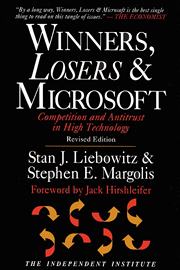Microsoft’s pricing policies, which are central to the antitrust case now underway in Washington, D.C., have come under increasing scrutiny since the recent release of a report by the Consumer Federation of America (CFA) and two other consumer groups.
Their conclusions can be summarized in two quotes: “Prior to the Microsoft software monopoly, prices invariably declined.” and “Microsoft’s prices for its monopoly products have increased dramatically.” They then take the difference between the purported increase in Microsoft prices and purported fall in other software prices to calculate a dollar value of Microsoft’s supposed overcharging.
The CFA study results are diametrically opposed to the results in a forthcoming book I have written with Stephen Margolis that I believe to be the most detailed examination of software markets to date. The seeming inconsistencies between our study and theirs result from errors in the CFA study, which is a lemon in need of a serious recall.
First, let me start with our study. We examined market shares, quality, and prices in 11 software submarkets. What we found was that Microsoft was the driving force behind price declines in many software markets. First, we examined the overall market. We examined how prices changed from 1988 to 1995 in all 15 major categories of consumer software as defined by Dataquest, a firm that analyzes computer markets. In 5 software categories where Microsoft did not have a product, prices fell by an average of 15 percent over the eight year period, with several periods of price increases. In the 10 categories where Microsoft had a product, prices fell by 65 percent.
So it seems clear that software prices do not always fall, and that Microsoft engenders price declines, which can be seen even more clearly in individual markets. Take the case of word processors. From 1986 to 1992, the average wholesale price increased from $130 to $168. Another blow against the CFA claim that software prices always fall. Of course, this was the period when WordPerfect was dominant. When Microsoft Word became the dominant product (in the early 90s), prices fell dramatically, to an average of less than $46 in 1997.
Spreadsheets tell a similar story. In 1986 the average wholesale price was $213. Prices then drifted up and down for a few years so that the average was $210 in 1990 and $177 in 1991. This was while Lotus 1-2-3 reigned. Excel took over leadership of this market in the early 1990s, and during Excel’s reign prices have fallen dramatically. By 1997 the average price of spreadsheets had fallen to $47.
Obviously, Office Suites helped lower these prices, but who should get credit for the Office Suite? Microsoft. It introduced the first Office Suite in 1990 (for the Macintosh), following up a year later in the Windows market.
Similar results were found in nonprofessional desktop publishing market. Microsoft entered the market in 1991 (with Microsoft Publisher) and achieved a leading market share of 60% by 1992. So what did it do after becoming the market leader? It lowered its wholesale price from $120 in 1992, when it already led the market, to $60 in 1996, a 50% drop in four years. By comparison, in the professional desktop publishing market, where Microsoft has no product, average prices rose from $372 in 1992 to $452 in 1996.
How can the CFA study be so at odds with the results just presented? Basically, they did not comprehend some studies that they relied upon, and when constructing their own data made inappropriate comparisons.
First, their charge that Microsoft raised prices is focused on Windows, and is a rigged comparison. As best I can tell, they compared the 1990 price of Windows 3.0 without including the separate DOS that was required to run Windows 3.0, and compared it to Windows 98, which contains its own form of DOS. This unequal comparison obviously overstates any price increase.
Although not part of our book, I looked at old computer magazine advertisements to find out what some actual prices were. In April of 1990, DOS 4.01 and Windows 386 together cost $205. In December of 1990, DOS 4.01 and Windows 3.0 cost $163. In April of 1998, a Windows 95 upgrade was $98 and the full version was $185. In November of 1998 the full version of Windows 98 cost $169 with the upgrade (which virtually everyone gets) only $85. This is not consistent with the claim of price increases, to say nothing of large price increases, and ignores the numerous additions to the operating system.
Far more revealing, I think, is the CFA’s methodology behind the claim that non-Microsoft software prices always fell, which we have already seen not to be the case. They base their conclusions on four referenced studies, one of which is to a single paragraph in Business Week that discusses a study of industry-wide prices over a two year period, surely too short a timespan to draw any conclusions.
The other three studies share the more fundamental problem of not supporting the CFA’s conclusions. Contrary to the CFA’s claims, these papers do not report that prices fell. Instead, they deal with hypothetical ‘quality adjusted’ prices and it is these quality-adjusted prices that fell. Since software increases in quality over time, quality adjusted prices can be expected to fall even though actual prices may have risen or fallen.
The CFA couldn’t even get their references right, in one case citing the wrong paper, although it wasn’t hard to figure out the paper they meant to cite. Perhaps we should lower the bar and overlook this. Indeed, we might even forgive the CFA’s exaggerated claim that the results in these studies hold for the entire software industry, when in fact two of these papers only examined spreadsheets, and the third examined only three markets (spreadsheets being one). What we definitely can not forgive is the CFA’s misrepresentation of these papers. Failing to properly cite a paper is one thing, failing to read it altogether quite another.
I don’t want to bore the reader with listings of other errors, but be assured that there are others. Interestingly, all of them seem to work against Microsoft.
Unbiased and careful studies will discover that Microsoft lowered prices even when it achieved very large market shares, quite the opposite of the nonsense now being promulgated by the CFA and the Department of Justice.
Perhaps Microsoft should be canonized for this behavior, perhaps not. But it doesn’t deserve to be blamed for wrongs it has not committed, and certainly not by ‘studies’ that are so poorly researched.










